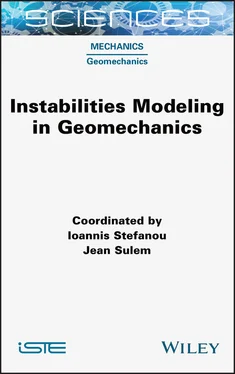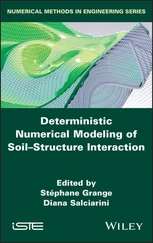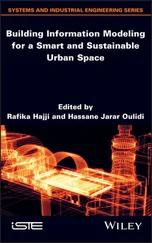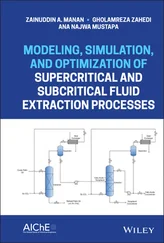Jean Sulem - Instabilities Modeling in Geomechanics
Здесь есть возможность читать онлайн «Jean Sulem - Instabilities Modeling in Geomechanics» — ознакомительный отрывок электронной книги совершенно бесплатно, а после прочтения отрывка купить полную версию. В некоторых случаях можно слушать аудио, скачать через торрент в формате fb2 и присутствует краткое содержание. Жанр: unrecognised, на английском языке. Описание произведения, (предисловие) а так же отзывы посетителей доступны на портале библиотеки ЛибКат.
- Название:Instabilities Modeling in Geomechanics
- Автор:
- Жанр:
- Год:неизвестен
- ISBN:нет данных
- Рейтинг книги:3 / 5. Голосов: 1
-
Избранное:Добавить в избранное
- Отзывы:
-
Ваша оценка:
- 60
- 1
- 2
- 3
- 4
- 5
Instabilities Modeling in Geomechanics: краткое содержание, описание и аннотация
Предлагаем к чтению аннотацию, описание, краткое содержание или предисловие (зависит от того, что написал сам автор книги «Instabilities Modeling in Geomechanics»). Если вы не нашли необходимую информацию о книге — напишите в комментариях, мы постараемся отыскать её.
Instabilities Modeling in Geomechanics — читать онлайн ознакомительный отрывок
Ниже представлен текст книги, разбитый по страницам. Система сохранения места последней прочитанной страницы, позволяет с удобством читать онлайн бесплатно книгу «Instabilities Modeling in Geomechanics», без необходимости каждый раз заново искать на чём Вы остановились. Поставьте закладку, и сможете в любой момент перейти на страницу, на которой закончили чтение.
Интервал:
Закладка:
1.5.3. Localization during drying of geomaterials
Cracking of geomaterials during drying is a purely mechanical problem, but highly coupled with the pore fluid flow. As per the definition, drying is a multiphase phenomenon with quite a complex multiphysics, including phase change, capillarity, flow, deformability and (perhaps) water cavitation during the phenomenon of air entry, which per se is a fluid–gas interface instability. In addition, it requires considerations to be made at three scales: macroscale continuum, mesoscale of grain and pore clusters, and microscale of individual pore structure or grains with liquid bridges. Hueckel et al . (2014) postulate that drying cracking consists of a series of processes, starting with evaporation of water at the external surface, inducing a negative liquid pressure and flow out from the deformable soil undergoing shrinkage in response. According to Terzaghi (1950), the air invasion takes place when the menisci at the saturated external soil surface reach the size of the biggest pores, but when the soil pores are deformable, it affects air entry. As for the drying cracking, it is postulated that an air finger entering the soil as an instability of the water/air interface ( Figure 1.18) constitutes a defect in the soil body, around which a stress concentration arises, when there are external constraints to shrinkage. An amplification of total tensile stress induces a localized high tensile effective stress, higher than the value of suction, resulting in a tensile failure, i.e. crack. Hence, a local value of air entry suction controls the local stress amplification at the defect. The mesoscale linear fracture mechanics analysis yields the stress values in the plausible range of tensile strength. In this scenario, the cracking needs to be considered at a continuum scale, while the air entry is a microscale phenomenon. In addition, the air entry requires a certain threshold suction to develop, which in turn changes the size of the pores. Hence, certain processes involved are sequential.

Figure 1.18. Evolution of the water body between eight glass spheres subjected to evaporation at a constant temperature and constant ambient vapor pressure. The arrow indicates a localized non-symmetric unstable mode of the interface evolution (air entry finger) (from Hueckel et al. 2014). For a color version of this figure, see www.iste.co.uk/stefanou/instabilities.zip
There is a host of other similar problems in which multiphysical behavior leads to instabilities, which have not been addressed here due to limited space. They include liquefaction and instability of rock faults and mine pillars related to earthquakes, breakthrough flow due to dissolution of minerals affecting permeability, sinkholes and mine collapses.
1.6. Conclusion
A wide range of failure, instability, non-uniqueness and strain localization phenomena developing in geomaterials have been reviewed in this chapter. It was concluded that in many real life problems, such occurrences result from complex multiphysical fields, including flow of pore water, differential thermal expansion of soil constituents, generation of heat through friction, geochemical reactions, evaporation and air invasion. Mechanical instabilities of the solid skeleton, while no doubt an important part of the overall behavior of geomaterials, do not exhaust the complexity of the overall behavior of such materials. A call for a comprehensive approach to multiphysics instability is more than due. The phenomena involved can be modeled as scenarios of processes that occur either simultaneously or sequentially and that are either coupled or depend on the accumulation of dissipative variables. Hence, the stability of such processes should be investigated as those of coupled mechanical, hydraulic, thermal and chemical processes, or as single processes of a sequence. In the latter case, instability of a one-step process likely affects the formulation of the successor process model. As pointed out by Terzaghi (1950), the causes of the instabilities are often long-term phenomena rather than single events, such as major rainfalls, which are contributing factors. The need for a proper description of these long-term phenomena and their coupling to variable mechanical properties of soil and rock is emphasized.
1.7. References
Bigoni, D. (2012). Nonlinear Solid Mechanics – Bifurcation Theory and Material Instability. Cambridge University Press, Cambridge.
Bigoni, D. and Hueckel, T. (1991a). Uniqueness and localization I. Associative and non- associative elastoplasticity. Int. J. Solids Struct. , 28(2), 197–213.
Bigoni, D. and Hueckel, T. (1991b). Uniqueness and localization II. Coupled elastoplasticity. Int. J. Solids Struct. , 28(2), 215–224.
Borrelli L., Antronico, L., Gullà, G. and Sorriso-Valvo, G.M. (2014). Geology, geomorphology and dynamics of the 15 February 2010 Maierato landslide (Calabria, Italy). Geomorphology , 208, 50–73.
Buscarnera, G. and Nova, R. (2011). Loss of controllability in partially saturated soils. In Bifurcations, Instabilities And Degradations in Geomaterials , Wan, R., Alsaleh, M. and Labuz, J. (eds). Springer.
Castellanza, R., Gerolymatou, E. and Nova, R. (2009). Experimental observations and modelling of compaction bands in oedometric tests on high porosity rocks. Strain , 45(5), 410–423.
Cecinato, F., Zervos, A. and Veveakis, E. (2011). A thermo-mechanical model for the catastrophic collapse of large landslides. International Journal for Numerical and Analytical Methods in Geomechanics , 35(14), 1507–1535.
Daouadji, A., Darve, F., Al Gali, H., Hicher, P.Y., Laouafa, F., Lignon, S., Nicot, F., Nova, R., Pinheiro, M., Prunier, F., Sibille, L. and Wan, R. (2011). Diffuse failure in geomaterials: Experiments, theory and modelling. Int. J. Numer. Anal. Meth. Geomech. , 35, 1731–1773.
Desrues, J., Chambon, R., Mokni, M. and Mazerolle, F. (1996). Void ratio evolution inside shear bands in triaxial sand specimens studied by computed tomography. Geotechnique , 46(3), 529–546.
Drescher, A. (2016). Private communication.
Drescher, A. and De Josselin de Jong, D. (1972). Photoelastic verification of a mechanical model for the flow of a granular material. Journal of the Mechanics and Physics of Solids , 20(5), 337–340.
Drucker, D.C. (1964). On the postulate of stability of material in mechanics of continua. J. Mécanique , 3, 235–249.
Gattinoni, P., Scesi, L., Arieni, L. and Marco Canavesi, M. (2012). The February 2010 large landslide at Maierato, Vibo Valentia, Southern Italy. Landslides , 9, 255–261.
Griffiths, D.V. and Lane, P.A. (1999). Slope stability analysis by finite element. Geotechnique , 49(3), 387–403.
Hallbauer, D.K., Wagner, H. and Cook, N.G.W. (1973). Some observations concerning the microscopic and mechanical behaviour of quartzite specimens in stiff, triaxial compression tests. Int. J. Rock Mech. Min. Sci. Geomech. Abs. , 10(6), 713–726.
Hicks, M.A. and Spencer, W.A. (2010). Influence of heterogeneity on the reliability and failure of a long 3D slope. Comput. Geotechnics , 37(7–8), 948–955.
Hill, R. (1958). A general theory of uniqueness and stability in elastic-plastic solids. J. Mech. Phys. Solids , 6, 236.
Hill, R. (1962). Acceleration waves in solids. J. Mech. Phys. Solids , 10, 1–16.
Hueckel, T. (1975). On plastic flow of granular and rocklike materials with variable elasticity moduli. Bulletin of the Polish Academy of Science , Engineering Sciences Series , 23(8), 405–414.
Читать дальшеИнтервал:
Закладка:
Похожие книги на «Instabilities Modeling in Geomechanics»
Представляем Вашему вниманию похожие книги на «Instabilities Modeling in Geomechanics» списком для выбора. Мы отобрали схожую по названию и смыслу литературу в надежде предоставить читателям больше вариантов отыскать новые, интересные, ещё непрочитанные произведения.
Обсуждение, отзывы о книге «Instabilities Modeling in Geomechanics» и просто собственные мнения читателей. Оставьте ваши комментарии, напишите, что Вы думаете о произведении, его смысле или главных героях. Укажите что конкретно понравилось, а что нет, и почему Вы так считаете.












